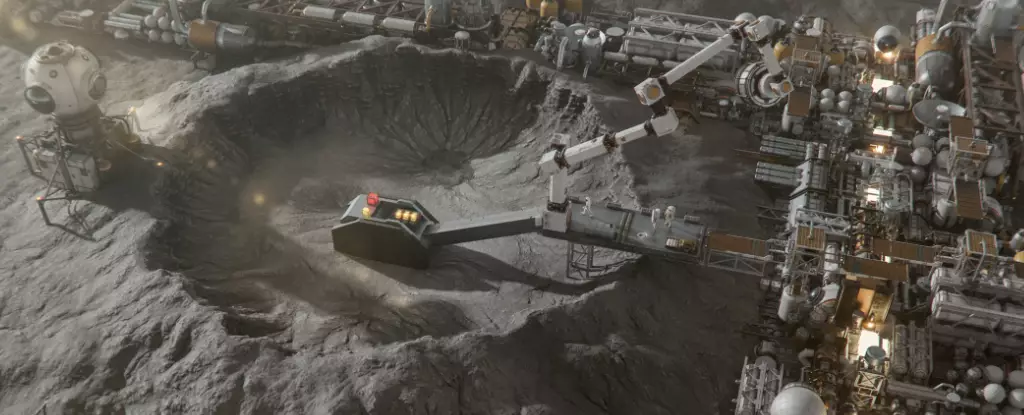As we approach the end of this decade, an intriguing and unprecedented chapter in space exploration appears imminent. Nations and private enterprises are gearing up to mine the Moon’s surface, heralding a new era of commercial and scientific endeavors beyond our planet. However, as accessible as space may soon become, it is crucial to contemplate the ethical landscape of lunar mining. We must ask ourselves what sort of commercial activities we deem appropriate while contemplating a sustainable future in space. This burgeoning lunar race calls for a critical examination of the rules and regulations that will govern human interactions with the Moon, an object that has inspired generations.
Political and Economic Motivations
NASA’s Artemis program aims to do far more than merely send astronauts back to the lunar surface; it is strategically designed to lay the groundwork for potential mining operations. Likewise, as nations compete for dominion in space, China is forging ahead with its lunar missions, creating a vibrant atmosphere for resource extraction. This situation gives rise to a virtual marketplace where private companies are racing to discover innovative methods for extracting the Moon’s resources. With necessities like fuel and water currently precariously transported from Earth at exorbitant costs, exploiting lunar resources could significantly lower these prices. For instance, converting Moon-based water ice into hydrogen and oxygen offers a tantalizing prospect: refueling spacecraft on-site, thus paving the way for deeper explorations, including Mars missions.
Furthermore, the Moon’s treasure trove of rare Earth metals represents an urgency underscoring the need for lunar mining. Today, Earth’s reserves are dwindling, and the prospect of utilizing the Moon as a supplementary site for high-demand materials is both environmentally and economically appealing. Thus, there could be a scenario where a nimble startup establishes lunar mining operations ahead of traditional space agencies, thereby rewriting the rules of resource competition in space.
Yet, with the promise of exploitation come environmental concerns. When resources are extracted from the Moon, the resultant dust clouds can travel extensive distances due to the Moon’s lack of atmosphere. This lunar dust is not only capable of altering the Moon’s visual landscape—where areas may become duller or brighter depending on the disturbance—but it also possesses the potential for far-reaching ecological ramifications. Sustainable mining practices must be at the forefront of lunar exploration initiatives; the management of lunar dust could prove critical in mitigating environmental degradation.
A sustainable approach becomes increasingly necessary as more companies explore lunar mining. Effective management practices could ensure minimal disruption to the delicate surface of the Moon, preserving both its aesthetic and scientific value for future generations.
Legal Framework: Navigating Ownerless Territory
The legal implications surrounding lunar mining are complicated and merit thorough analysis. The 1967 Outer Space Treaty explicitly decrees that no nation can claim ownership of the Moon or any celestial body. However, the nuances surrounding commercial extraction are ambiguous, presenting a conflict of interpretations. The 1979 Moon Treaty champions the idea of the Moon’s resources as “the common heritage of mankind,” which often translates into prohibitive interpretations against commercial lunar mining.
In contrast, the Artemis Accords of 2020 seem to offer a more lenient perspective, allowing resource extraction while emphasizing that no ownership claims should be made. As nations and corporations race to mine the Moon, the actual implications of these treaties become crucial in determining whether lunar resources benefit only a select few or are distributed equitably among all nations on Earth.
As we advance into this new frontier, human rights and worker safety must also take center stage. Fulfilling the promise of lunar mining should not come at the expense of workers’ health and welfare. Those venturing into these inhospitable, low-gravity conditions will undoubtedly face unique challenges, including heightened exposure to cosmic radiation and immense psychological stress due to prolonged isolation.
Research from prominent astrobiologists, such as Charles S. Cockell, posits that lunar environments could cultivate “space tyranny,” wherein vulnerable workers may have limited recourse against negligent or exploitative employers. Therefore, establishing regulatory bodies to safeguard workers’ rights and enforce safety standards—despite their physical separation from Earth—is an essential yet daunting challenge.
The Moon stands at the crossroads of innovation and responsibility, serving as a potentially limitless supply of resources for future generations. However, the lessons of history remind us to approach such endeavors with caution. As nations and private entities prepare to exploit lunar resources, we must instill robust regulations focused on fairness, safety, and human rights. A conscientious approach will not only safeguard the well-being of lunar workers but also ensure that our exploration continues to inspire and unite humanity. Our collective journey into the cosmos should reaffirm our commitment to ethical stewardship and sustainability, leaving a celestial legacy worthy of our greatest aspirations.

